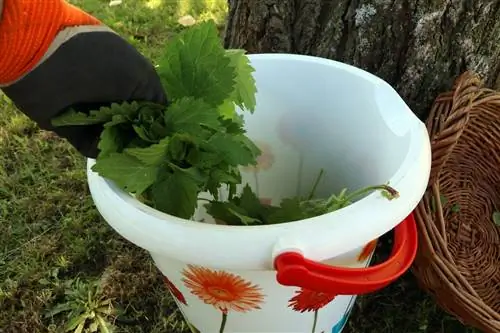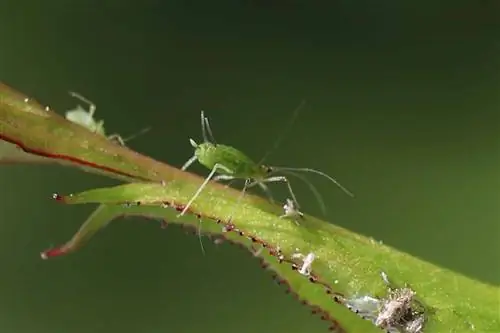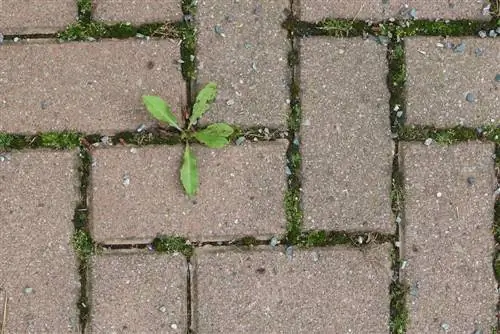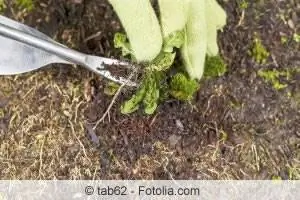- Author admin [email protected].
- Public 2023-12-24 17:10.
- Last modified 2025-01-24 12:45.
The decoction of nettles can be used to combat aphids in an environmentally friendly and organic way. However, the remedy is not a miracle weapon, so the plants should be checked frequently for infestation. Nettle decoction is not only very effective in the early stages of aphid infestation. It can also be used against annoying weeds that spread between paving stones, rolled surfaces or on the steps of stairs and are difficult to remove.
Which nettles are suitable?
Stinging nettles (Utica) belong to the nettle family and are found almost everywhere in the world. The large nettle (Urtica dioica) and the small nettle (Urtica urens) are particularly widespread here. The upper parts of the plant of both types are suitable for making nettle broth, with the smaller type being considered the more aggressive. Harvesting is best done on a sunny day in early May, just before flowering. Dead nettles (Lamium) belong to a different plant genus and are therefore unsuitable.
Using nettle decoction
The smell and some active ingredients from the nettle have a repellent effect on lice and spider mites. The brew also contains nutrients that strengthen the plants. Nettle decoction can also be sprayed on leaves and flower buds to combat deficiency symptoms.
- Spray leaves and shoots with the decoction against aphids, spider mites and whiteflies
- Root bath for wilting potted plants
- When sprayed, it also works against leaf chlorosis (as fertilizer)
- acts as a bioherbicide against weeds
Ingredients
The nettle not only contains formic acid as a defensive substance, which the pests tolerate poorly, but also a whole host of other plant active ingredients and nutrients. These are released into the brew and are therefore easily available to the plants. These include:
- Iron
- other minerals
- Flavonoids (antioxidants)
- Carotenoids (antioxidants)
- Vitamins A, C and E
- Phosphorus
- Potassium and calcium
- Nitrogen
- Silicic acid (strengthens the cell walls and the immune system)
- Amines (in the stinging hairs) promote the greening of the leaves
Materials needed
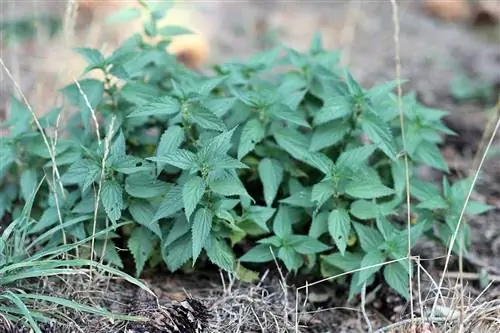
If you want to make nettle broth for pest control or weed destruction, you need a few things that are usually available in every household with a garden:
- Stinging nettles
- Water (preferably rainwater)
- Bucket and grid for covering
- Roses scissors
- possibly hand blender
- Gardening Gloves
sieve
Picking nettles
Which gardener doesn't know this: in the spring, tons of stinging nettles grow in the beds, under trees or on the compost. But the unloved plant is not only annoying, it can also be wonderfully harvested to make a natural and completely organic pesticide. The nettles can be pulled out or cut off as painlessly as possible if the gardener wears gardening gloves.
- Time: in spring before flowering
- only use leaves and soft plant parts
- the bigger the leaves, the better
- Half fill the bucket with the nettles
- Shredding leaves and stems with rose scissors
Tip:
If you harvest nettles in the wild, you should cut off each individual plant in the middle of the stem. Because this way the nettle grows back faster.
Make the brew
The smaller the nettle leaves are cut, the better they can decompose and release their active ingredients into the water. Rainwater is best for filling, but alternatively you can use normal drinking water from the garden hose.
- Quantity of nettles: about 1 kg
- Amount of water: about 10 l
- Let it wilt for about 8 hours before adding water
- Storage location: shady and protected from rain
- Secure the bucket with a grid (so that no animals or leaves fall into it)
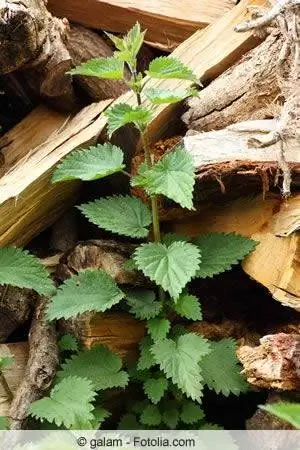
In principle, there are two different approaches to the nettle broth. Gardeners have had good experiences with both variants. Which approach you choose is a matter of taste. When it comes to home-made herbal broths, the motto is always that you can and should experiment a little to get the best results.
Cold water extract
The plant parts of the nettle are placed in cold water (rainwater) for a few hours. Then you strain out the solid components and you can use the nettle broth immediately.
- Minimum soaking time: 12 hours
- maximum exposure time: 48 hours
- the brew must not ferment strongly yet
Hot water extract
To make nettle broth, the chopped plant parts are placed in water for 24 hours and allowed to steep. Then boil the entire stock (including the leaves) in a large pot.
- about 1 kg of fresh nettles per 10 l of water
- alternatively 150 g dried nettles
- simmer gently for about 30 minutes
- cooling down
- sieve out solid components
- dilute
- can be used immediately
Application
After two days, the nettle broth can already be used as a biopesticide (against pests) and bioherbicide (against weeds). The cold water extract can be used immediately. Hot water extracts should not be applied directly to the leaves but should be diluted first.
- Dilution: 1:5 to 1:10
- Outdoor plants: remove coarse solids, chop fine residues with a hand blender
- fill into a watering can with a shower attachment
- water directly over the leaves of the plants
- for houseplants: filter the broth through a sieve or an old kitchen towel
- fill into a flower spray bottle and spray leaves (including the underside)
- spray at least once daily
- Repeat the process at least three days in a row
- if no more aphids are visible, spray a few more times
- repeat the procedure after about two weeks (following generation from eggs)
Tip:
Always spray nettle broth on a cloudy day. If you spray the decoction on the plants in bright sunshine, you have to expect burns on the leaves.
Stinging nettle manure

After a few days - or even sooner if the brew is in the sun - the mixture begins to ferment strongly. This can be recognized by the fact that foam forms on the surface of the water and the broth smells unpleasant. At this point, substances have already formed that would cause burns on the leaves and fresh shoots of the plants. However, the fermenting nettle broth does not have to be thrown away. Simply leave it for a few days longer (about two to three weeks in total) and stir once a day so that a nettle slurry forms. The fermentation process should definitely be completed before use. This can be recognized by the fact that foam no longer forms.
Which approach for which application?
Many instructions use different names for the individual approaches and standing times of chopped nettles in water and swear by one variant or the other. The difference between a nettle broth, a broth and a nettle manure is not that big:
- Even a short time in cold water releases ingredients that are effective in combating pests (called nettle broth or cold water extract)
- The subsequent boiling of this mixture is usually referred to as nettle broth (hot water extract or tea)
- Boiling large quantities of the nettle-water mixture is usually very complicated
- With the nettle manure, the mixture has stood in a warm, sunny place for at least two weeks and fermentation is completely complete
- Stinging nettle manure can also be used to combat aphids and weeds
- spray or water only diluted (at least 1:10) onto the plants
Tip:
Cold extracts, teas and broths (hot extracts) of nettle do not smell as strong, which is why they are particularly suitable for houseplants.
Conclusion
Stinging nettle broth is ideal for biological control of sucking pests and weeds in the garden. There are different ways to prepare the mixture. Soaked in cold water, the nettle broth can be used undiluted after just one or two days. Infusions with hot water and nettle liquid are just as effective alternatives. However, they must be diluted at least 1:5 with water before use and then sprayed or poured onto the leaves of the plants.

